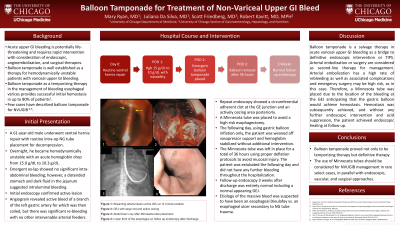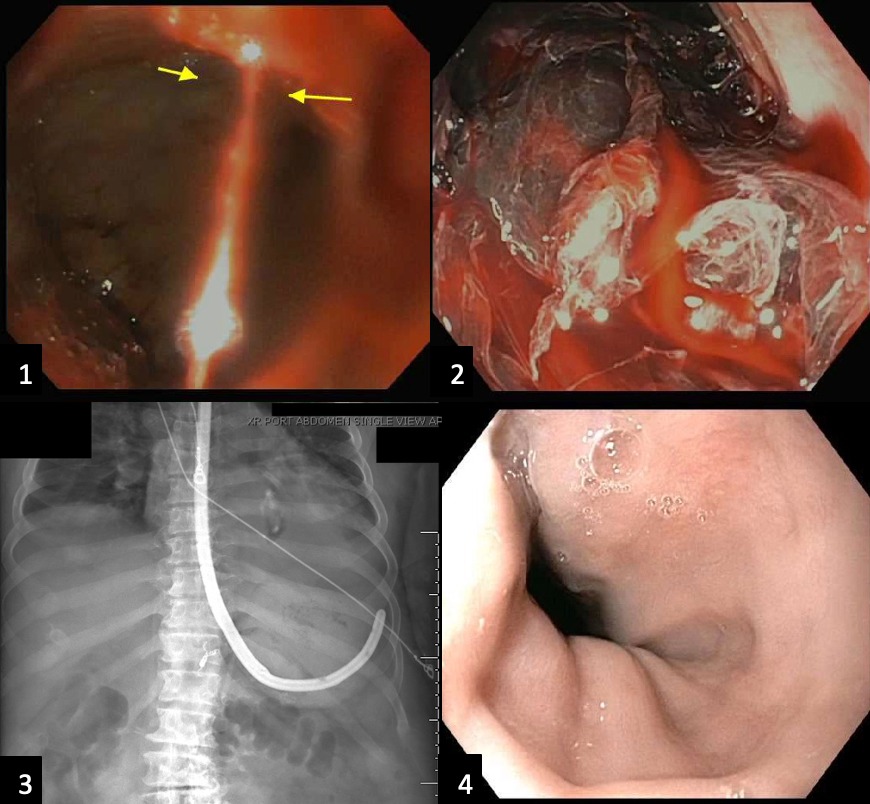Sunday Poster Session
Category: GI Bleeding
P0637 - Balloon Tamponade for Treatment of a Non-Variceal Upper GI Bleed
Sunday, October 22, 2023
3:30 PM - 7:00 PM PT
Location: Exhibit Hall

Has Audio

Mary Ryan, MD
University of Chicago
Chicago, IL
Presenting Author(s)
Mary Ryan, MD, Juliana Da Silva, MD, Scott Friedberg, MD, Robert Kavitt, MD, MPH
University of Chicago, Chicago, IL
Introduction: Balloon tamponade is commonly used for bleeding esophageal varices, but its application in non-variceal upper gastrointestinal bleeding (NVUGIB) is limited. We present a case of massive NVUGIB managed definitively with Minnesota tube placement after failed initial and secondary therapies.
Case Description/Methods: A 61-year-old male underwent ventral hernia repair with routine intra-op NG tube placement. Post-op course was complicated by hemodynamic instability and an acute hemoglobin drop from 15.0 g/dL to 10.3 g/dL. On repeat ex-lap, there was no significant intra-abdominal bleeding; however, a distended stomach and dark fluid in the jejunum suggested intraluminal bleeding. Endoscopy revealed a pulsatile stream of blood at the gastroesophageal junction (GEJ) anteriorly and a second area of bleeding posteriorly. Epinephrine injection and IR embolization were attempted but unsuccessful, prompting Minnesota tube placement to avoid an emergent esophagectomy. The following day, using gastric balloon inflation only, the patient was weaned off vasopressor support and hemoglobin stabilized without additional intervention. The Minnesota tube was maintained for 36 hours and no further bleeding was observed. He was discharged on post-op day 8. Follow-up endoscopy 3 weeks later was normal including a normal appearing GEJ. The initial bleed was thought to have been an esophageal Dieulafoy or an esophageal ulcer from NG tube trauma.
Discussion: Balloon tamponade is used as a salvage therapy in acute variceal upper GI bleeding as a bridge to definitive endoscopic intervention or TIPS. In cases where endoscopic therapy fails, arterial embolization or surgery are considered as second-line therapies for management of acute upper GI bleeding. In the case we have described, arterial embolization failed to achieve adequate hemostasis, and emergency surgery was considered too high risk. Therefore, a Minnesota tube was placed as an attempt at salvage therapy due to the location of the bleeding at the GEJ. Hemostasis was subsequently achieved, and without further endoscopic intervention and acid suppression, the patient achieved endoscopic healing on follow-up.
This case contributes to the growing literature of the use of Minnesota tubes for the treatment of NVUGIB. It proved not only to be a temporizing therapy but definitive therapy as well. The use of Minnesota tubes should be considered in the armamentarium for NVUGIB management in select cases, in parallel with endoscopic, vascular, and surgical approaches.

Disclosures:
Mary Ryan, MD, Juliana Da Silva, MD, Scott Friedberg, MD, Robert Kavitt, MD, MPH. P0637 - Balloon Tamponade for Treatment of a Non-Variceal Upper GI Bleed, ACG 2023 Annual Scientific Meeting Abstracts. Vancouver, BC, Canada: American College of Gastroenterology.
University of Chicago, Chicago, IL
Introduction: Balloon tamponade is commonly used for bleeding esophageal varices, but its application in non-variceal upper gastrointestinal bleeding (NVUGIB) is limited. We present a case of massive NVUGIB managed definitively with Minnesota tube placement after failed initial and secondary therapies.
Case Description/Methods: A 61-year-old male underwent ventral hernia repair with routine intra-op NG tube placement. Post-op course was complicated by hemodynamic instability and an acute hemoglobin drop from 15.0 g/dL to 10.3 g/dL. On repeat ex-lap, there was no significant intra-abdominal bleeding; however, a distended stomach and dark fluid in the jejunum suggested intraluminal bleeding. Endoscopy revealed a pulsatile stream of blood at the gastroesophageal junction (GEJ) anteriorly and a second area of bleeding posteriorly. Epinephrine injection and IR embolization were attempted but unsuccessful, prompting Minnesota tube placement to avoid an emergent esophagectomy. The following day, using gastric balloon inflation only, the patient was weaned off vasopressor support and hemoglobin stabilized without additional intervention. The Minnesota tube was maintained for 36 hours and no further bleeding was observed. He was discharged on post-op day 8. Follow-up endoscopy 3 weeks later was normal including a normal appearing GEJ. The initial bleed was thought to have been an esophageal Dieulafoy or an esophageal ulcer from NG tube trauma.
Discussion: Balloon tamponade is used as a salvage therapy in acute variceal upper GI bleeding as a bridge to definitive endoscopic intervention or TIPS. In cases where endoscopic therapy fails, arterial embolization or surgery are considered as second-line therapies for management of acute upper GI bleeding. In the case we have described, arterial embolization failed to achieve adequate hemostasis, and emergency surgery was considered too high risk. Therefore, a Minnesota tube was placed as an attempt at salvage therapy due to the location of the bleeding at the GEJ. Hemostasis was subsequently achieved, and without further endoscopic intervention and acid suppression, the patient achieved endoscopic healing on follow-up.
This case contributes to the growing literature of the use of Minnesota tubes for the treatment of NVUGIB. It proved not only to be a temporizing therapy but definitive therapy as well. The use of Minnesota tubes should be considered in the armamentarium for NVUGIB management in select cases, in parallel with endoscopic, vascular, and surgical approaches.

Figure: Figure 1: Streaming arterial lesion at the GEJ at 12 o’clock position
Figure 2: GEJ with large clot and active oozing
Figure 3: Abdominal x-ray after Minnesota tube placement
Figure 4: Lower third of the esophagus on follow up endoscopy after discharge
Figure 2: GEJ with large clot and active oozing
Figure 3: Abdominal x-ray after Minnesota tube placement
Figure 4: Lower third of the esophagus on follow up endoscopy after discharge
Disclosures:
Mary Ryan indicated no relevant financial relationships.
Juliana Da Silva indicated no relevant financial relationships.
Scott Friedberg indicated no relevant financial relationships.
Robert Kavitt indicated no relevant financial relationships.
Mary Ryan, MD, Juliana Da Silva, MD, Scott Friedberg, MD, Robert Kavitt, MD, MPH. P0637 - Balloon Tamponade for Treatment of a Non-Variceal Upper GI Bleed, ACG 2023 Annual Scientific Meeting Abstracts. Vancouver, BC, Canada: American College of Gastroenterology.

